| Welcome, Guest |
You have to register before you can post on our site.
|
| Online Users |
There are currently 292 online users.
» 5 Member(s) | 285 Guest(s)
Bing, Google, davidma, KJ now
|
| Latest Threads |
Month names collection / ...
Forum: Marginalia
Last Post: davidma
19 minutes ago
» Replies: 55
» Views: 1,317
|
Critique wanted
Forum: Voynich Talk
Last Post: KJ now
23 minutes ago
» Replies: 0
» Views: 6
|
It is not Chinese
Forum: Voynich Talk
Last Post: Jorge_Stolfi
28 minutes ago
» Replies: 127
» Views: 4,002
|
Wherefore art thou, aberi...
Forum: Imagery
Last Post: Juan_Sali
10 hours ago
» Replies: 47
» Views: 2,128
|
A method I have made to t...
Forum: Analysis of the text
Last Post: project963
Yesterday, 10:23 AM
» Replies: 74
» Views: 8,770
|
Upcoming Voynich program ...
Forum: News
Last Post: Gregor
Yesterday, 08:08 AM
» Replies: 10
» Views: 1,386
|
Pisces (Folio 70v) and th...
Forum: Astrology
Last Post: Dobri
16-06-2025, 07:20 PM
» Replies: 34
» Views: 4,643
|
Which plaintext languages...
Forum: Analysis of the text
Last Post: Rafal
16-06-2025, 04:19 PM
» Replies: 17
» Views: 2,787
|
Favorite Plant Tournament...
Forum: Voynich Talk
Last Post: Koen G
14-06-2025, 08:11 PM
» Replies: 0
» Views: 125
|
Favorite Plant Tournament...
Forum: Voynich Talk
Last Post: Koen G
14-06-2025, 08:09 PM
» Replies: 0
» Views: 118
|
|
|
| [split] BessAgritianin's reading of 116v |
|
Posted by: BessAgritianin - 13-05-2024, 06:45 AM - Forum: Marginalia
- Replies (47)
|
 |
Hello everybody, I have a truthful interpretation of 116V .
My work is in Acrobat format. How and where may I post it?
Second question is the authorship. What about the copyrights of the works published on your page?
Best regards!
|

|
|
| Different scribes, similar plants? |
|
Posted by: Bernd - 08-05-2024, 02:35 AM - Forum: Imagery
- Replies (4)
|
 |
Looking at the flowers in the VM for quite some but not nearly enough time, I have made some interesting observations.
Following Koen's thread and blog post about differences in A and B plants, I also looked at different scribal hands as proposed to Lisa Fagin Davis.
Most plants were drawn by scribal hand 1 which covers all of Currier A and also shows the greatest variability.
The Currier B pages are divided between scribal hand 2, 3 and 5
Scribal hand 2 draws the cleanest and most 'sophisticated' flowers, it is hard to describe but they have a certain vibe to it. This scribe appears to have the best drawing skills. Most 'VM-daisies' and the enigmatic rosette- like flowers of f33v, You are not allowed to view links. Register or Login to view. and You are not allowed to view links. Register or Login to view. are drawn by this hand. But also some quite simple and messy ones like You are not allowed to view links. Register or Login to view. or f31r.
Scribal hand 3 appears to be closer to 2 than to 1 and overall has pretty well drawn flowers.
Scribal hand 5 appears rather messy, closer to 1 than to 2.
The most bizarre feature is that while some plants of scribe 2 stand out, most plant drawings fall within the same spectrum of VM oddities and show very similar quirks and share patterns which I find very hard to explain if we assume these drawings were made by different people. When I learned botanical drawing at university (I was always terrible at it) I was baffled how differently students would draw the exact same plant before them. People not only differ in drawing skills but also perception and pay attention to or miss details that others don't. In the VM this mostly is not the case, on the contrary. Different scribes draw plants that have eerie similarities. Some appear to be copied but that again raises the question why different people would copy a plant or parts of plants and rearrange them.
So without further ado, let's look at some examples:

Plant duplicates in the pharma section are well known but few have flowers or fruit. Here we see 2 clearly identical plants by scribal hand 1 except for the root system.
Also well known the 3 plants with thee red berries
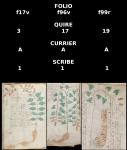
The same scribal hand 1 draws the same plant 3 times in the VM. Despite the slightly different leaves and bifurcated stem in You are not allowed to view links. Register or Login to view. and the missing terminal tendril and extra branch in You are not allowed to view links. Register or Login to view. we clearly see the strong similarities in root, leaves and fruit.
Let's look at the plant with campanula-like flower:
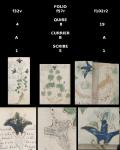
It is drawn 3 times, 2 times by scribal hand 1 which are perfectly similar and once by scribal hand 5 which shows stylistic differences and a moderately different root but still is very recognizable.
My favorite are those strange flowers with bulbous calyx, no idea what this is supposed to be.
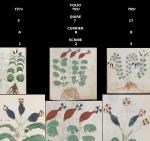
We again have 3 plants from 3 different scribal hands. You are not allowed to view links. Register or Login to view. by hand 1 and f95r1 by hand 3 share extremely strong similarities down to the coloration of flowers. You are not allowed to view links. Register or Login to view. by scribal hand 2 has somewhat different leaves and differently colored flowers but still it is hard to believe that this drawing evolved independently from the others. So we have 3 scribal hands bit extremely similar flowers.
From here things get a bit odd. Let's look at the 'mosses'
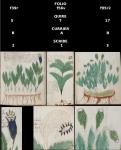
Again 3 plants from 3 scribes. You are not allowed to view links. Register or Login to view. by scribal hand 2 is an odd plant or rather an odd flower which doesn't match the plant at all which appears to be either a monocot or bryophyte. We find an almost exactly similar plant with similar root table in f95r2 drawn by scribal hand 3 but instead of a flower it has capsules or sporangia typical for mosses. In comparison we have another 'moss' in You are not allowed to view links. Register or Login to view. drawn by scribal hand 1. It looks vastly different, has no root table and serrated leaves but the 'flower' appears to be a sporangium with a toothed peristome typical for a moss like Polytrichum. See more here:
You are not allowed to view links. Register or Login to view.
There is one more triad although more doubtful and strangely it contains the third plant on the foldout of f94v-f95r1-f95r2
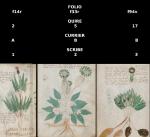
All 3 plants by scribal hands 1, 2 and 3 share a composite flower, arrow-shaped leaves arranged in a fan. The root system is less clear but vaguely similar. I do not believe these drawings necessarily depict the same plant but they share a common design. I am not really sure what to make of it. It should be noted that apart from the campanulas, all of the duplicate plants have at least 1 member in Q17.
Last but not least, we close with another peculiar composite plant where scribe 1 recycles overall plant shape and inflorescence but swaps out the leaves to a pinnate version.
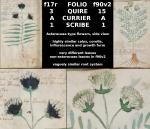
I find it highly likely that these 2 plants and especially the inflorescence are a copy, maybe even autocopy. There appears to be a general tendency to copy and recycle plant parts and my feeling is they were constructed from a stock of shapes or themes. This also would explain the similarities between some flower shapes and the rosette page.
[attachment=8510]
Honestly I really don't know what to make of all this but to me the most striking discovery are the similarities between scribal hands. Why did they draw such similar plants? Did they copy each other? Even then I find it hard to imagine how one would end up with such similarities. I think like with the text we must not make the mistake tho throw everything in the same pocket. The plants may very well have very different origins, some being faithful drawings of living plants, some copies or autocopies and others creations of imagination. Probably even a mixture.
One giant task would be to divide all VM plants into flower, leaves and root system and compare them independently as well as the overall plant shape. Also We should look for similar drawings in contemporary herbals, not necessarily in whole but at least in parts.
|

|
|
| Hardest plants to identify? |
|
Posted by: Koen G - 05-05-2024, 05:22 PM - Forum: Imagery
- Replies (12)
|
 |
I was reading parts of the thread about most certain plant ID's, and came across You are not allowed to view links. Register or Login to view. by DONJCH:
(13-01-2019, 11:39 PM)DONJCH Wrote: You are not allowed to view links. Register or Login to view.I just wanted to say that this is a really useful thread.
Equally useful might be a thread about those plants that nobody has any clue about whatsoever.
So for people who have tried identifying the plants - which are the ones that really make the least sense from a botanical perspective? Which ones require the most nudging and squinting to get them to resemble anything that actually exists?
|

|
|
| A Universal Template |
|
Posted by: HermesRevived - 04-05-2024, 09:06 PM - Forum: News
- Replies (29)
|
 |
Further adventures in templates for Voynichese.
We can create a 12 x 12 matrix from only two words, set in cycles, with a few simple rules, that will accommodate any Voynich word whatsoever. In fact, any portion of Voynichese, necessarily so.
You are not allowed to view links. Register or Login to view.
|

|
|
| A commercial project aimed at women from high society |
|
Posted by: amelkin - 04-05-2024, 03:34 PM - Forum: Provenance & history
- Replies (13)
|
 |
In the 15th century in Upper Bavaria, something unusual was happening in high circles. The unfortunate medieval Bavarian duchesses were forced to annually bring an heir to the duke, turning into a "maternity machine". Their life could have become unbearable if not for one circumstance. The court physician Johannes Hartlieb, together with other court specialists, developed a commercial project aimed at women from high society - a series of "Voynich Manuscripts" - sophisticated hoaxes. These manuscripts did not use a cipher, but an imitation of a cipher, and the five pieces of the extant manuscript differ from each other lexically, and this clearly indicates that there were several manuscripts, and they were used as a sales tool. Lacking sufficient education in the field of astrology, alchemy and medicine, the duchesses nevertheless became interested in sessions of white magic, for which strange manuscripts were ideally suited. For ladies it was great entertainment, and for court doctors, balneologists, herbalists, advisers, writers and poets it was a source of good income. The duchesses, who conducted sessions of white magic in various Bavarian castles, predicted the fate of the ladies and gave recommendations on how to achieve "happiness", and the doctors and other specialists, for an appropriate fee, wrote out prescriptions and referrals, gave advices, composed "magic" poems, compiled individual horoscopes, etc. And now, 600 years after it was written, the Voynich Manuscript continues to bring income for scientists, publishers, filmmakers, bloggers, etc. I have identified the circle of possible authors of the Voynich Manuscript and its "victims". In the near future I will find evidence of the correctness of my theory. It is a pity that many castles and documents no longer exist.
|

|
|
|